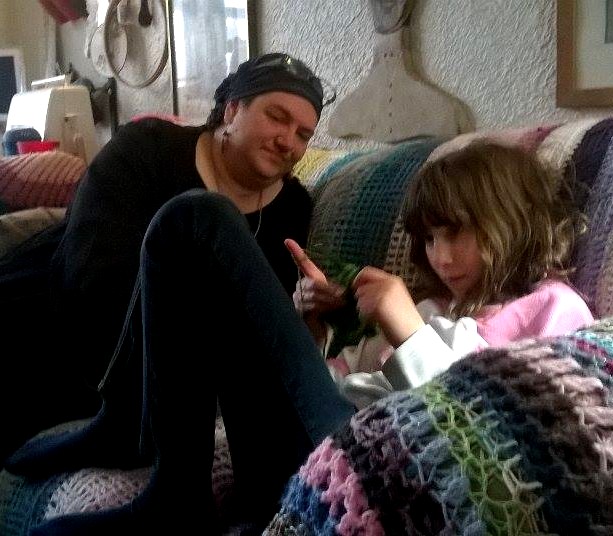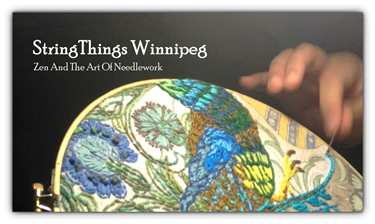One of my favourite blogs, Crochet Concupiscence, has a list of questions that people can use to self-interview. This blog is all about crochet, and I do a number of needlecrafts, primarily sewing, weaving, embroidery, spinning and crochet, so my questions/answers are a bit different. Still, it’s a good way to think seriously about how string became the organizing principal of my life. And since I am currently snowed in following a blizzard, here is section one: learning to craft with fabric, thread and yarn…
All About Learning The Textile Crafts
Q1. When did you learn needlework?
A1. I came very late to the textile crafts. I was already in my mid 40s before I began and I am only 50 now. My grandmother had taught me a bit of crochet when I was 8 or so, but she had difficulty teaching a left-handed kid with learning disabilities that included directional confusion. It was frustrating for both of us.
In grade 7 I took a class called crafts (very unwillingly). The teacher was old-fashioned and refused to let me knit ‘backwards’ aka left-handed. The two of us struggled over a 12″ teddy-bear made of horrid blue variegated acrylic for the whole semester, with her smacking my left hand with a knitting needle every time she found me knitting left-handed. To this day I don’t like to knit!
My real start in needlework came via a general commitment to living more simply, I wanted to learn to sew enough to make myself a simple wardrobe of long dresses and pinafores. Basically I was aiming for the life and wardrobe of the Crones pictured above. (One of those is me!) And now that’s pretty much my life!
Q2. How did you learn your textile crafts?
A2. I learned almost everything on my own with books, the internet, and especially with YouTube tutorials. I love that I love that I can search for left handed tatting tutorial and get a beautiful complete playlist of all of the basic techniques. Honestly, videos can be so patient; they don’t mind demonstrating the same technique over and over and over!
I have PTSD and when I the first few years that I was learning and exploring textile crafts I was pretty much crippled with agoraphobia, anxiety and panic. Although I was working very hard on getting more mobile I was very isolated. So it was several years before I could get any personal instruction. but once I could get to R., my weaving instructor, all of that work was worth it. She is the only in-person teacher I have worked with and I learned 4-shaft loom weaving from her.
I learned sewing, tapestry weaving, off-loom weaving, tatting, surface freehand embroidery, pillow-lace, kumihimo, and crochet on my own.
Q3. What are your fondest memories of learning textile skills?
A3. It’s really the same moment, over and over again. It’s that moment that I call the ‘click’ and one of my students called ‘satori’, the moment that everything settles perfectly into your hands, when suddenly the yarn hold is perfect, the stitch is simple, the moment I feel like I can fly. Sometimes it’s quick and sometimes it’s slow (I am looking at YOU tatting!) but eventually the basic movements become sensually pleasing and automatic. That is when the practice of that craft can become mindful, alert and focused timeless time. When the hands are busy the mind becomes free.
Q4. What was easiest / most difficult about learning?
A4. The person who showed me crochet as an adult is a right-handed pencil grip-style crocheter. I, on the other hand, am a left-handed knife-style crocheter, so that was a challenge! Once I found a left handed demo online It all fell into place very quickly and truthfully, each new skill requires focus but nothing has been terribly difficult. I trust my instincts to guide me to the projects I am ready for, and so far those instincts have not led me astray. Handedness has been a big focus for me as a teacher after suffering through awkward attempts at teaching me various skills without knowing how to approach an opposite handed student. Thank goodness for YouTube!
Q5. What’s the next thing that you would like to learn?
A5. I would really love to learn the heritage types of crochet, Bosnian and Irish lace especially. I am very intrigued by the look of the Pjoning (or Bosnian) hooks – and there is nothing like a new textile tool to lure me into a new craft.
Q6. What made you interested in learning yarn and thread-crafts?
A6. Well, I discovered embroidery just by being gifted with some amazing English tea-towels. I thought maybe I’d try a little outlining and then got carried away!
Originally though, I started with sewing. then I got obsessed with weaving. Weaving has to be the single most unwieldy, time consuming, and expensive craft to become obsessed with. Honestly, I was afraid to pick up another craft after that! But the crafts and the textile tools just keep seducing me. I didn’t much care for crochet until I tried a knitter’s pride symfonie dreamz hook at my LYS (local yarn store) a couple of years ago. I hate the intentional misspelling but those hooks just feel so good in my hands! And spinning became an everyday craft when I discovered Turkish spindles. I don’t know, I just seem to develop a crush on another tool or craft every so often. One nice thing is that nothing looks expensive after a floor loom! I saved for years to get mine.
Q7. Have you taught anyone else?
A7. Yes! As best I can estimate, at least 400 people over the last year or two!
Q8. What is the most important thing you would want to tell someone who is just learning?
A8. The most difficult part of learning any new skill is learning to tolerate the distress of being bad at it. Everyone feels clumsy and frustrated as they work to get a new skill from their mind to their hands and learning to just relax, keep practising, and trusting that it will come is the most valuable lesson I can teach. Pick tools, materials and projects that inspire you! It will help you stay motivated. The feeling you get when the skill just clicks into focus, it’s just indescribably satisfying. I have found serenity, focus, community, purpose and self-confidence through crafting and teaching. I hope others will find whatever they need too.


















What a fab post! You certainly know your stuff about all things string related 😊
LikeLiked by 1 person
Thank you so much! I’m glad you enjoyed it!
🙂
Baba
LikeLike
I’m pretty much self taught as well. It kind of makes you feel like you can do anything once you catch on to a new technique. I think it’s amazing how you overcame agoraphobia and anxiety to be able to teach others.
LikeLiked by 1 person
Hi Judy!
Thank you very much!
And I agree with you about the great feeling of teaching yourself a new skill. ❤
LikeLike